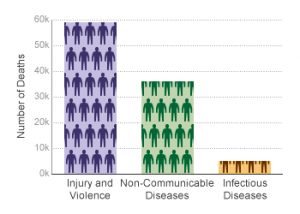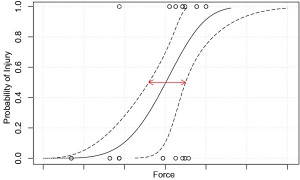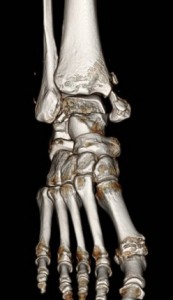Epidemiology

Epidemiology is the basic science for public health and complements biomechanical injury research in its fundamental pursuit to understand the cause(s) and mechanism(s) of injury, so that appropriate prevention and control measures can be identified, designed and implemented to have the greatest effect for minimizing loss to the community.
Injuries remain a significant public health concern and have continually been the leading cause of death for those between the years 1-44 in the United States (Figure 1), primarily as a result of motor vehicle collisions (MVC). MVCs have also been shown to account for more years of potential life lost than any other disease. Globally, injuries and violence account for nearly 1 out of every 10 deaths each year, while millions of others seek medical treatment as a result of injury.
Establishing Methods for Estimating Risk

Whether investigating high ankle sprains among football players, thoracic trauma to an MVC occupant, pelvic fractures to our military services members from improvised explosive devices, or any of the myriad at-risk populations we study, understanding the injury problem is the first step for any effective prevention solutions to be realized. Injury surveillance and field data analyses are the primary means by which researchers can quantify the nature and magnitudes of the event, injury, and fatality burden experienced in the real world and identify issues and factors for further in-depth investigation.

Analysis of databases like FARS and NASS-CDS enable us to understand injury events and trends over time and at the national level in relation to large safety initiatives, in addition to determining factors associate with the risk of injury. As one the six Crash Injury Research and Engineering Network (CIREN) centers in the U.S., CAB is directly involved in the reconstruction of real-world crash events that are matched to known injury outcomes occupants. With collaborative expertise in engineering, medicine, epidemiology and crash reconstruction, CIREN teams are able to provide in-depth characterization of injury scenarios and their likely mechanisms. Once identified and characterized, observations made from field surveillance data can be better understood and translated into quantitative engineering data by designing controlled experiments in the lab setting to accurately isolate and measure the actual contribution of specific risk factors (e.g., change of velocity, individual age, protective equipment technology) in relation to the energies experienced by the person and the resulting injury risk to tissues and skeletal structures. Furthermore, field data are critical for adding support toward establishing priorities and directing the allocation of limited laboratory resources to solve the most significant real-world problems.
Examples of data sources that help describe the prevalence of injury types:
- Fatality Analysis Reporting System (FARS)
- National Automotive Sampling System (NASS)
- Crash Injury Research & Injury Network (CIREN)
- National Collegiate Athletic Association Injury Surveillance System (NCAA ISS)
- National Electronic Injury Surveillance System (NEISS)
- Survey of Occupational Injuries and Illnesses (SOII)
- National Fire Incident Reporting System (NFIRS)
- National Trauma Data Bank (NTDB)
- Naturalistic Driving Study (SHRP 2 NDS)